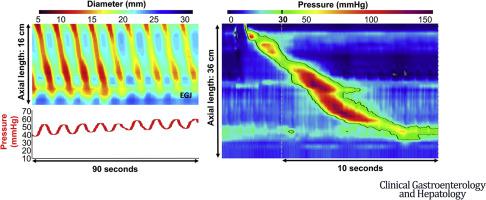Clinical Gastroenterology and Hepatology ( IF 11.6 ) Pub Date : 2020-03-20 , DOI: 10.1016/j.cgh.2020.03.040 Alexandra J Baumann 1 , Erica N Donnan 1 , Joseph R Triggs 2 , Wenjun Kou 1 , Jacqueline Prescott 1 , Alex Decorrevont 1 , Emily Dorian 1 , Peter J Kahrilas 1 , John E Pandolfino 1 , Dustin A Carlson 1

|
Background & Aims
A normal esophageal response to distension on functional luminal imaging probe (FLIP) panometry during endoscopy might indicate normal esophageal motor function. We aimed to investigate the correlation of normal FLIP panometry findings with esophageal high-resolution manometry (HRM) and outcomes of discrepant patients.
Methods
We performed a retrospective study using data from a registry of patients who completed FLIP during sedated endoscopy. We identified 111 patients with normal FLIP panometry findings (mean age, 42 y; 69% female) and corresponding HRM data. A normal FLIP panometry was defined as an esophagogastric junction (EGJ) distensibility index greater than 3.0 mm2/mm Hg, an absence of repetitive retrograde contractions, and a repetitive antegrade contraction pattern that met the Rule-of-6s: ≥6 consecutive antegrade contractions of ≥6-cm in length, at a rate of 6 ± 3 contractions per minute. HRM findings were classified by the Chicago classification system version 3.0.
Results
HRM results were classified as normal motility in 78 patients (70%), ineffective esophageal motility in 10 patients (9%), EGJ outflow obstruction in 20 patients (18%), and 3 patients (3%) as other. In patients with EGJ outflow obstruction based on HRM, the integrated relaxation pressure normalized on adjunctive swallows in 16 of 20 patients (80%), and in 8 of 9 patients (88%) who completed a barium esophagram and had normal barium clearance. Thus, although 23 of 111 patients (21%) with normal FLIP panometry had abnormal HRM findings, these HRMs often were considered to be false-positive or equivocal results. All patients with an abnormal result from HRM were treated conservatively.
Conclusions
In a retrospective cohort study, we found that patients with normal FLIP panometry results did not have a clinical impression of a major esophageal motor disorder. Normal FLIP panometry results can exclude esophageal motility disorders at the time of endoscopy, possibly negating the need for HRM in select patients.
中文翻译:

正常功能性管腔成像探头全景测量结果与高分辨率测压中缺乏主要食管运动障碍相关。
背景与目标
内窥镜检查期间,功能性管腔成像探针(FLIP)全景测量中食管对扩张的正常反应可能表明食管运动功能正常。我们的目的是调查正常 FLIP 全景测量结果与食管高分辨率测压 (HRM) 的相关性以及差异患者的结果。
方法
我们利用镇静内窥镜检查期间完成 FLIP 的患者登记数据进行了一项回顾性研究。我们确定了 111 名 FLIP 全景测量结果正常的患者(平均年龄 42 岁;69% 为女性)和相应的 HRM 数据。正常的 FLIP 全景测量被定义为食管胃交界处 (EGJ) 扩张指数大于 3.0 mm 2 /mm Hg,不存在重复性逆行收缩,并且重复顺行收缩模式符合 6 规则:≥6 个连续顺行收缩宫缩长度≥6厘米,宫缩频率为每分钟6±3次。 HRM 结果按照芝加哥分类系统 3.0 版进行分类。
结果
HRM 结果分为食管运动正常 78 例(70%)、食管运动无效 10 例(9%)、食管胃结合部流出道梗阻 20 例(18%)、其他 3 例(3%)。在基于 HRM 的 EGJ 流出道梗阻患者中,20 名患者中有 16 名 (80%) 的综合舒张压在辅助吞咽后恢复正常,9 名完成食管钡餐造影且钡剂清除率正常的患者中有 8 名 (88%) 恢复正常。因此,尽管 111 名 FLIP 全景测量正常的患者中有 23 名 (21%) 具有异常的 HRM 结果,但这些 HRM 通常被认为是假阳性或模棱两可的结果。所有 HRM 结果异常的患者均接受保守治疗。
结论
在一项回顾性队列研究中,我们发现 FLIP 全景测量结果正常的患者没有重大食管运动障碍的临床印象。正常的 FLIP 全景测量结果可以排除内窥镜检查时的食管动力障碍,可能不需要某些患者进行 HRM。











































 京公网安备 11010802027423号
京公网安备 11010802027423号